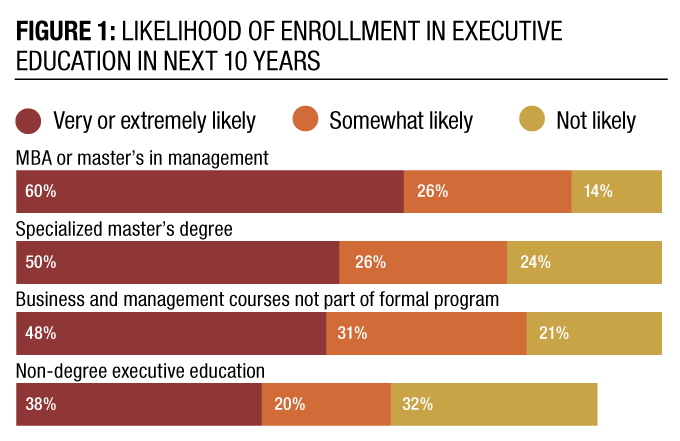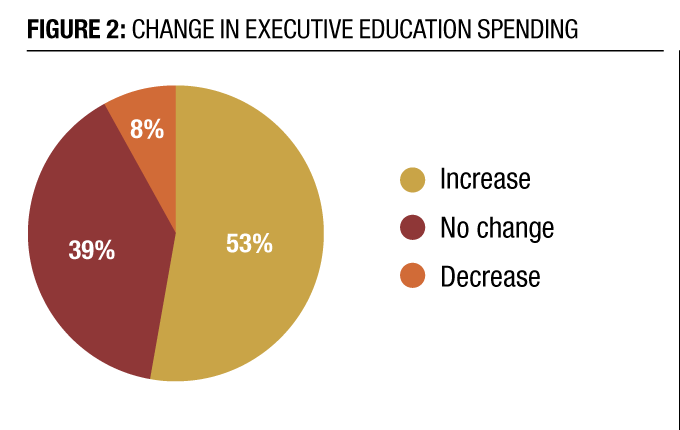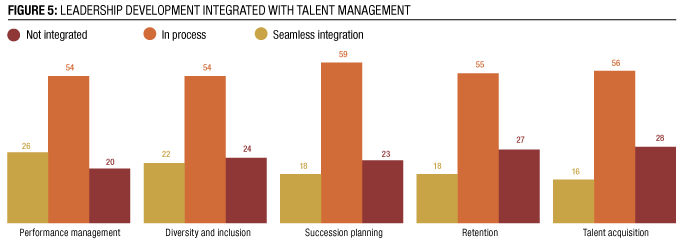Executive education remains a widespread development tool, popular with the learning departments that fund that education and well-liked by the individuals who go through the programs.
According to a 2017 survey of 1,665 early to midcareer professionals, 60 percent say they are very likely or extremely likely to pursue a master’s degree in management. Further data from that study, conducted by AACSB, an association of business schools, EMBAC, a council of executive MBA programs, and UNICON, a consortium of executive education providers, show that half of them plan to pursue a specialized graduate degree (Figure 1).

For their part, chief learning officers plan to continue and, in some cases, grow their investment in executive education to keep pace. According to data from the Chief Learning Officer Business Intelligence Board, 92 percent of learning organizations either plan to increase their spending in executive education or keep it the same (Figure 2).

The Chief Learning Officer Business Intelligence Board is a group of 1,500 professionals in the learning and development industry who have agreed to be surveyed by the Human Capital Media Research and Advisory Group, the research and advisory arm of Chief Learning Officer magazine. This survey was conducted from January to March 2018.
Further analysis of companies’ spending plans on a per-person basis show similar support, with a slight uptick from plans in 2017 (Figure 3). This year, 10 percent of learning organizations plan to invest more than $10,000 per executive, compared to 8 percent last year. In 2017, 24 percent planned to spend between $4,000 and $10,000, compared with 26 percent this year. At the low end, 65 percent plan with spend less than $4,000 in 2018, compared with 68 percent last year.

The top three priorities for that spending are consistent year over year. Organizations want to use executive development to grow the succession pipeline, retain high-potential employees and foster innovation and creative thinking (Figure 4).

When asked if their executive development plans integrate with their broader talent management goals, a minority of learning executives indicated it was a seamless process (Figure 5). The majority report integration with key processes such as performance management, retention and succession planning remain a work in progress. Furthermore, nearly one-quarter said executive development is not integrated with diversity and inclusion at all.

Digging into the needs of those professionals looking to pursue an MBA or specialized master’s degree reveals more interesting trends. According to the AACSB/EMBAC/UNICON study, 80 percent of professionals who said they are likely to pursue a higher degree want education that is more self-directed and developed in partnership with their employer versus a traditional program.
Nontraditional education options are also becoming more attractive to students. Ninety percent of those surveyed reported finding some value in certificates and digital badges as a substitute or complement to traditional education credentials. One-quarter said those credentials could even substitute for a degree, according to the AACSB/EMBAC/UNICON survey.
Only 1 in 10 are not at all likely to pursue a certificate or badge. Change is coming even to the hallowed halls of executive education.
Mike Prokopeak is vice president and editor in chief at Chief Learning Officer magazine. He can be reached at editor@CLOmedia.com.














